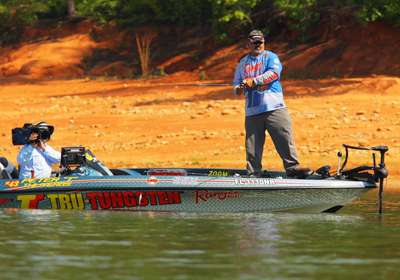
Trying to pinpoint postspawn bass can be a guessing game even with all the sophisticated electronics we have today.
Former Bassmaster Elite Series pro Peter Thliveros takes a lot of the guesswork out of finding fish migrating back to their deep-water haunts by dragging a Carolina rig. "It's a tool that covers water efficiently. You can fish it slow and still cover a lot of water," says Thliveros.
The Florida pro favors rigging on flats with scattered stumps, grass or small rockpiles. "The fish are loose and roaming a lot then," he says. "They're not necessarily on the bank and not necessarily off of it either. So it's one of those things that when you're fishing it along you can hit stuff that you can't see, which is the kind of stuff postspawn fish gravitate toward."
Because the fish can be anywhere along the flats, Thliveros positions his boat parallel to the bank and fancasts the structure. "Boat positioning is not critical as long as you maintain the right water depth," says Thliveros. He drags his rig from 2 to 10 feet deep throughout the postspawn, but most of his strikes occur in the 6- to 8-foot range.
A 6-inch Zoom plastic lizard and Zoom Ol' Monster plastic worm in green pumpkin, watermelon and watermelon/red flake hues are Thliveros' favorite lures for rigging. "I like lures that present a pretty good profile," says Thliveros, who sometimes throws an 8-inch Zoom lizard when he needs to catch a kicker fish. The components of Thliveros' rig include a 5/8-ounce mojo-style tungsten sinker followed by a bead (to create noise and protect his knot) and a swivel on a main line of 17-pound fluorocarbon.
Just about any size swivel will work on the rig, according to the Florida pro. "When you have a big old hunk of tungsten and a bead in front of it, the size of the swivel isn't going to matter," says Thliveros.
Postspawn bass tend to be lethargic after the rigors of spawning, so Thliveros prefers using a longer leader (3 feet) in warmer water. The fish will usually be roaming from the cover or suspended off the bottom during the postspawn, so when the sinker on a rig with a longer leader hits the cover, the lure glides away from the target to trigger strikes from the roaming fish.
Thliveros opts for a heavy leader line (15-pound test fluorocarbon) so he can drag his rig through the cover, especially when the sinker makes contact with either stumps or rocks. Tied on the end of his leader is a 4/0 worm hook. Thliveros drags his rig with a 7 1/2-foot American Rodsmiths Mag Strike Predator Series rod (medium-heavy action) with an Ardent XS1000 baitcast reel (6.3:1 gear ratio). A slow, steady pull best describes Thliveros' Carolina rig retrieve. When his sinker hits cover, Thliveros pauses his retrieve.
While some anglers shake or hop their lures during the retrieve, Thliveros sticks with a steady pull because he believes the commotion caused by the weight and bead banging on the bottom is enough to trigger strikes. The rig produces postspawn bass for Thliveros whether the water is clear or dirty, though he opts for something else when the water is extremely muddy.
"As long as you can't track a coon through it, the rig will work," says Thliveros, who also drags a rig whether it's sunny, calm, overcast or windy. "There might be other things that work better under those circumstances, but the Carolina rig is a steady producer."
Originally published May 2011





